Blade 130 S
The sure fire hit for backyard fun.
by John Salt
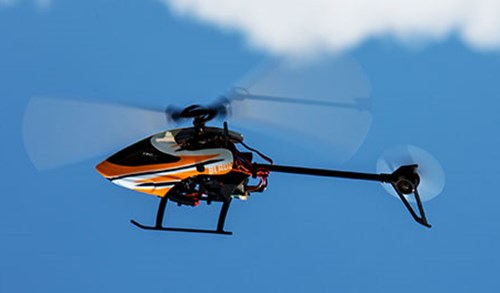 Click Image For Ordering Information
Click Image For Ordering InformationI finally got to try out the Blade 130 S a friend of mine just purchased and yes, I'm impressed. As I'm forced to get back into micro helis since Transport Canada's BS, the 130 S is certainly a viable option as it weighs less than the 250g threshold, 170g to be exact.
I was (still am), as many know, a pretty big fan boy of the 130X, despite its short comings (ongoing maintenance mostly tail related I might add).
It was and still is the perfect size backyard BNF collective pitch RC helicopter in my opinion. The new 130S takes over where it left off, building on the perfect size for this flying environment, and doing away with the maintenance annoyances.
A fixed pitch motorized tail that actually works?!
Okay, let me get this out of the way before going any further. I have always despised motorized fixed pitch tail rotors on anything other than very tiny micro RC helicopters.
They simply had and still have horrid tail holding
performance, response, and life spans - or so I thought... Yep, I'm now eating humble crow after
flying the 130S.
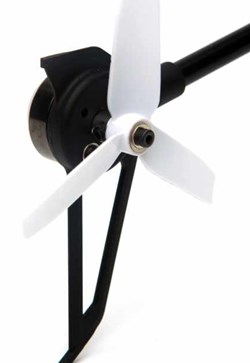 Blade 130 S Tail Motor & Tri-Blade Tail Rotor
Blade 130 S Tail Motor & Tri-Blade Tail RotorThe long life brushless tail motor along with the fixed pitch tri-blade tail rotor not only responds incredibly fast, those three tail blades give the tail rotor a good amount of "air grip".
They also provide fast deceleration thanks to the increased drag to practically eliminate over-blow-out when main rotor torque is rapidly reduced.
The strong
brushless motor however provides very fast acceleration to deal with
main rotor torque spikes. In short, the tail hold and response on the
130 S is pretty much as good as it was on the variable pitched 130X's
tail.
So, pair a small enough CP heli with a fixed pitch tri blade tail rotor being driven off a strong brushless motor, is a working combination.
Of course, the secondary benefit is all the mechanical maintenance hassles with the variable pitch tail on the 130X have more or less been eliminated.
Those where small
little variable pitch parts on the 130X's tail after all, and were
naturally fragile, not to mention the high rotation speeds involved. The
bearings had short lives, the drive gears and shaft holes wore and
stripped out very easy, and vibration was the norm. If you wanted to
learn more about the tail hassles on the original 130X, I cover them in
my review of that heli.
The
next most common part to fail on the original 130 was the tail boom. It
was a small, thin walled, hollow square carbon boom that was super easy to crack or split
if you had anything more than a light tail first crash, even into soft
grass.
The tail boom on the 130 S however is larger, stronger, and made from aluminum so splitting it is no longer possible. I'm sure it can be bent, but it's going to take a good deal more than a "soft'ish" ass first ground strike.
Blade 130 S Micro Linear Servos
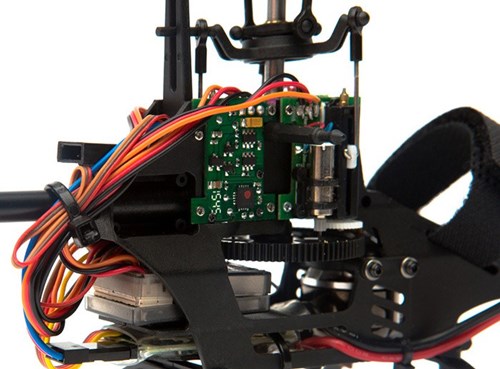
Love em or hate em, micro linear servos are still used on the blade 130 S like on the X version. They have both pros and cons. The best thing about them is they are all but impossible to strip out due to the worm gear driving the output arm.
Impact energy simply can not be transmitted through the worm gear to
the tiny drive gears. You will snap ball links, break balls off, or bend
pushrods long before damaging a micro linear servo's gears.
The
draw back with micro liner servos is they get the "shakes". The
potentiometer sliders get dirty (especially around center where the FBL
unit is making constant stabilization corrections), and that causes them
to hunt rapidly.
They can be cleaned however to extend the life which I go over in my Setup & Tips ebook. Cleaning usually cures the shakey-shakey, but a new micro linear may also be required after extensive use and slider wear.
So linear servo maintenance vs. gear
stripping - you decide. The Blade 180 CFX or T-Rex 150X are the natural other heli options in a
similar sized packages if you want standard rotary servos.
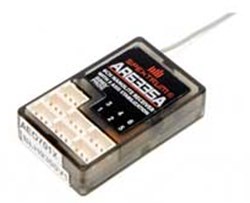 Spektrum AR6335A
Spektrum AR6335ASince I just mentioned the FBL unit, that is a good segue into the blade 130 S's flybarless system.
Like the 180 CFX, the 130 S also uses the Spektrum AR6335A combination 6 channel RX with AS3X flybarless stabilization built in (part #BLH9321).
This is a major difference between this version of the 130 and the original X version that used a combo-board with all the components including the ESC & BEC. The AR6335A is a great micro flybarless unit and I can't get over the more advanced features it boasts which include:
- Cyclic & Tail Independent PID Gyro Gain Adjustment
- Cyclic Response Speed Adjustment
- Tail Rotor Adaptive Filtering Adjustment
- Telemetry
- Servo Centering Adjustment
- Trim Programming
- Optional Spektrum programming cable available for more programming access (part # SPMA3065)
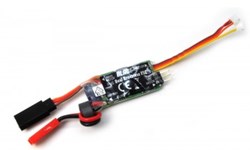 Blade 130 S ESC/Tail Mixer
Blade 130 S ESC/Tail MixerSince the AR6335A RX has no built in ESC, a separate main and tail rotor ESC with tail mixing and built in BEC is used on the 130S (part # BLH9318).
The similarities to the larger 180 CFX don't end with the electronics. All the rotor head components are shared with the 180 - the head, the grips, the bearings, the head links, and the swashplate.
The 130s also uses a metal main shaft instead of a carbon one like the X version used. That carbon shaft could split with a strong enough blade strike, but the metal shaft can bend. Your call which is a better shaft material but my money is on the metal one.
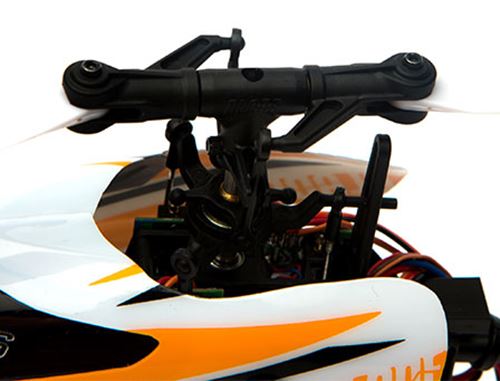 Blade 130S Head Components Shared With 180 CFX
Blade 130S Head Components Shared With 180 CFXThis is another robust improvement over the original 130. I rarely had "head issues" with my 130X; any head issues were limited to the person piloting the thing, but a few times I bent the feathering shaft and broke the grip balls off if I didn't pin them.
This beefier head should more or less cure those few issues. I had to fly this little bird rather calmly of course as it wasn't mine to test the limits of bendy breakage, but my buddy had a few good "powered down" impacts into the grass and the little Blade 130 S kept coming back for more.
I stress powered down because hitting hold before hitting something will greatly increase your chances of doing no damage to the heli. This little bit of advice holds true for all micro size helis, not just the 130S.
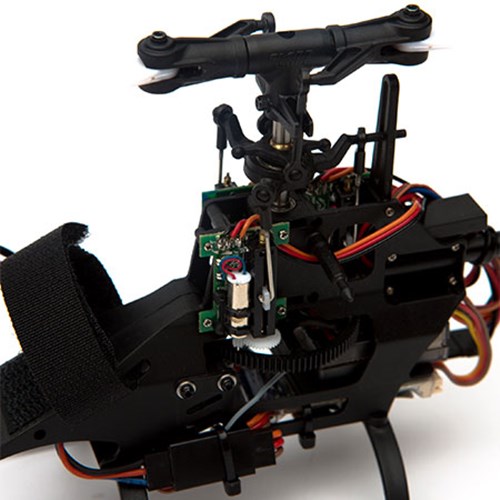 Blade 130 S Mechanics & Frame Layout
Blade 130 S Mechanics & Frame LayoutThe Blade 130 S frame set is very much like all of Blades plastic frames. They come in two halves, are light weight, and are practically indestructible. I have yet to break any Blade helicopter plastic frame set, even on the 450's. They are strong where required, and flexible where they need to be to absorb impact or vibration energy it seems.
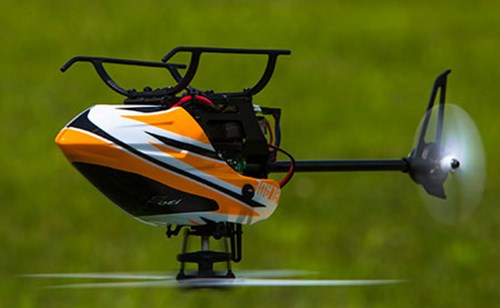 Easy To See Canopy
Easy To See CanopyI must say, I preferred the green canopy graphics on the original version, but you can certainly see the new tangerine, white, and black scheme on this one better, especially while flying in the yard with green tree backgrounds.
If you liked how your 130 X flew, you'll like this version too.
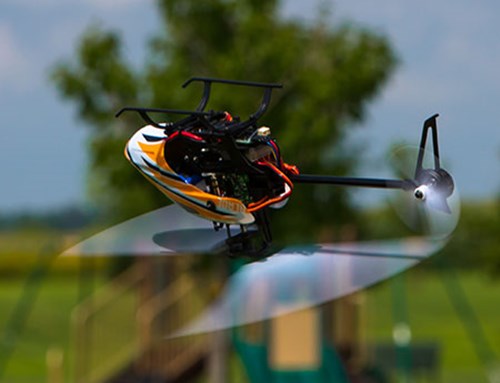
The
Blade 130 S, flies and feels very similar to the original 130X, despite the heavier weight (170g S, 107g X). That is a fair amount of weight difference on a heli of this size, but the more powerful motor and 3S voltage seems to absorb it and then some. Flight times suffer however, more on that shortly.
In SAFE "Stability Mode", it actually behaved somewhat like the fixed pitch 120 S, with it's limited cyclic pitch & roll angle and self leveling engaged. It's more reactive, but not by much and some extra positive exponential or
dual rates could certainly tame it down further to near 120 S performance. In short, you could certainly forgo the fixed pitch 120S with the 130 S if you know a bit about collective pitch setup.
What was not that impressive with the 130 S however was flight time. Even in this soft & slow mode with gentle flying, pushing 4 minutes keeping the LiPo within the safe 80% discharged state was about the best I was able to achieve. The 130 X can do 6 minutes plus no problem flying gentle this way so the extra weight and extra power being drawn from the tail motor obviously has an impact.
I suppose I could have tried dialing down the throttle curve a bit to reduce power consumption. The head speed did seem fairly high in normal mode with the factory recommend 75% hover point throttle output, so I'm sure experimentation down as low as 65% power at the hover point would be doable, maybe even lower?
Speaking of recommended factory settings for the pitch & throttle curves, dual & expo rates in all modes. They are good starting points for sure, but can certainly be tweaked better to suit the individual.
What I really don't understand is the use of +25% expo in both dual rate settings of 100% and 75%?
This gave a
different mid stick response I found and my preference as well as my
friend's, was to run 100% dual rate at +35% expo and +25% expo with the
reduced 75% dual rate settings.
I like a calmer tail and no cross stick tail movement with collective banging so using an even higher positive expo when at both 100% & 75% dual rate on the tail would be my preference, but this was his machine and he had it dial in for what he liked. He runs fairly high spring tension on his sticks as well so that certainly helps.
"Intermediate Mode" was my
personal favorite and as I mentioned before, tail blow out on acell or
decel was next to impossible to initiate. Impressive for a FP tail rotor! For light
aerobatics, this was my favorite flight mode and what reminded me of my 130X's
so much. It just behaves so well for a helicopter of this small size.
Loops can be made big and round and stress free inverted practice is
where it really shines.
I only used "Panic Recovery"
once to see how well it worked. To be perfectly honest, I'm not a fan
of save or rescue, but
it seemed to work for the most part and did upright the heli when
inverted and kept it fairly level with minor drifting after the "save". I would
much rather try to save it
myself, especially on a little micro heli like this to learn important
"stressed out rescue skills", but to each their own. Average flight time
in agility (80% flat line throttle curve)... a disappointing 3 minutes!
"Agility Mode" was again very much like what I've become accustomed to on my
130X but certainly more powerful despite the added weight. It becomes a fast little humming bird for the lack of a better
description (in the hands of a good 3D pilot which I am not).
I would rather get more flight time flying more gentle aerobatics and inverted practice but no question, this little bugger has the power to pull off tic-tocs, rainbows, and pitch pumps, without much loss of rotor energy - better than the 130X for sure in the power department.
Flight times are dismal at under 2.5 minutes however (100% flat line throttle curve). In fact, 2 minutes if you are really banging the collective with the stock Eflite 3S 300 mAh LiPo battery.
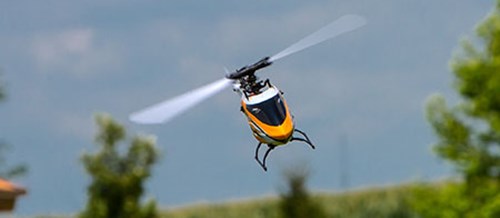 130S looking good nose in!
130S looking good nose in!Blade 130 S Battery Options?
We need more Blade 130 S LiPo battery options, plain and simple.
My obvious biggest beef with the Blade 130 S is undoubtedly the short flight
times. They are a good minute shorter on the S version over the X given
the same flying styles based on my experiences with both. So can it be
improved is the question?
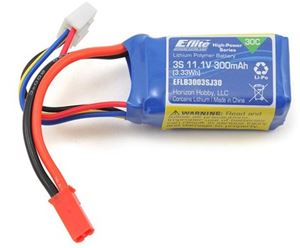 Blade 130 S LiPo Battery
Blade 130 S LiPo BatteryAs of right now (May 2017), there is only one true Blade 130 S battery, the stock Eflite 3S 300mAh 30C one that weighs in at 28g (part #EFLB3003SJ30).
This of course
will change in time as the aftermarket LiPo world comes out with 130S
specific options, but till then, it's experiment time.
Of
course, like most of us electric RC fliers, one of the first things I
consider before purchasing a heli I'm interested in is what battery
options are available.
First off, what packs do I already have that
might work? Well, nothing in this case. The smallest 3S packs I own are
800mAh for my 250's so no go there - way too big. Battery shopping will
be inevitable if I get the 130 S.
Also,
like most of us, paying top dollar for OEM batteries is another pitfall
when you can get better packs for at least half the price.
To be honest,
that EFLB3003SJ30 Eflite pack is not outrageously priced at $15 bucks, but you can
bet if/when Glacier, Turnigy, Pulse Ultra, or Gens-Ace come out with a workable
option, the costs will likely be half of that while also having more
capacity.
Until then, here
are some workable options I have considered and what a few of my web
visitors have confirmed will work well. Please feel free to contact me if you know of other good LiPo options for the 130s.
First off, the very largest you can go is about 450 mAh. Much larger and the size makes canopy fitment difficult if not impossible not to mention the added weight on an already fairly heavy micro heli which then starts to introduce tail issues. The little bit of good news on the weight front however is this heli is unfortunately tail heavy due to that big brushless tail motor.
Even with the factory Eflite 3S 300mAh pack pushed far forward
on the tray, the CG is still slightly tail happy. This makes a slightly
heavier 350mAh to 450mAh a viable option provided the size is not too big
and the weight not much over 40g. The size of the Eflite 3S 300mAh 30C pack is 38mm long x 21mm wide x 17mm high, and as I mentioned tips the scales at about 28g.
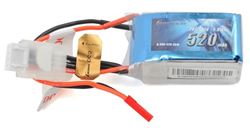 Gens-Ace 3S 520mah 30C 130S - A Popular Option
Gens-Ace 3S 520mah 30C 130S - A Popular OptionListed in order of positive feedback I've been getting and my own research as to what packs I have considered if I choose to get my own Blade 130 S, here are some 3S options with the required JST RCY power plug.
That
said, please do keep your eye out on the aftermarket for actual 3S 130S
purpose built packs. Like I said, I'm sure they are only weeks away if
that!
- EZFlite 3S 350mAh 35C (size: 47mm x 20mm x 21mm - weight: 31g) $8.00
- Gens-Ace 3S 520 mAh 30C (size: 46mm x 23mm x 22mm - weight: 46g) $11.00
- Glacier 3S 450 mAh 25C (size: 58mm x 30mm x 14mm - weight: 45g) $6.00
- Turnigy Nanotech 3S 370mAh 25-40C (size: 60mm x 31mm x 13mm - weight: 39g) $6.00
Pulse Ultra also has a 3S 450mAh pack, but it's fairly heavy. No one recommended it (likely for that reason), but it came up in my searching as a possible option ($8.00 range).
Blade 130 S Specifications & Owners Manual
- Heli Classification: Micro Collective Pitch 130 Size
- Versions: ARF & BNF
- Radio System Compatibility: Spektrum DSMX 11ms
- Swash & Stabilization Type: eCCPM Flybarless
- Main Motor: Brushless Outrunner 5650kv
- Tail Motor: Brushless Outrunner 4700kv
- FBL System: Spektrum AR6335A
- Heli Length: 304mm
- Heli Height: 114mm
- Main Rotor Diameter: 310mm
- Tail Rotor Diameter: 64mm
- Gross Weight: 170g
- LiPo Battery: 3S 300mAh 30C / Main Plug JST RCY / Balance Plug JST-XH 3S
- Flying Environment: Indoor/Outdoor
Final Blade 130 S Thoughts
So, like many reading this, I'm in the same boat right now. Do I throw down my money on the Blade 130 S, keep flying my maintenance intensive 130 X's, or perhaps look at some other collective pitch BNF Blade offering under the 250g threshold to fly in my own yard without pissing off the Canadian government in the process?
Time to tick off the pros & cons boxes...
Pros:
- Perfect size for practicing acro in the yard
- Flies Great
- Low maintenance BL motorized FP tail rotor (that actually works)
- Low parts count
- Crash resistant
- Nice micro FBL unit
- SAFE enabled with 3 flight modes and panic recovery
- Easy to see color scheme
- BNF (if you have Spektrum/JR DSM2/X TX already)
Cons:
- Short flight times
- Limited LiPo battery options (so far)
- BNF Basic version comes with no battery
- Fairly expensive (heli & replacement parts)
No question, I really like this new version of the Blade 130 and it flies so well, but the short flight times are not at all appealing.
That is after all why I
don't really like flying micro CP helis period; the flight times are at
least half of what my larger birds get. With the Blade 130 S, it almost
seems like I would be going even further backwards in this respect. No
question, larger capacity packs will cure this issue to some extent, but
the flight time issue is something I can't easily dismiss.
Next
is cost. The 130S is not exactly inexpensive at $200USD for the BNF
Basic version (doesn't come with a LiPo), plus the cost of six or so
LiPo packs to have any amount of back to back flight fun. Update, price has been dropped to $170USD
$200 beans is the
same cost as the 180 CFX BNF Basic (which comes with a LiPo battery & more aftermarket battery options) and
I do like the features on the 180 better as I don't need or even want
SAFE to be perfectly honest. The 180 is not much larger (just over an inch/40mm longer) and although
I've never flown one, I can see it being a very nice "backyard" and
under 250g option as well (it tips the scales at 190g, only 20g more
than the new 130S).
130 S
or 180 CFX? I'll have to get new LiPo packs with either option and costs
are more or less identical for both helicopters and parts. I feel you
get more helicopter and better bang for the buck with the 180 CFX if you
don't need the SAFE stability and panic recovery features the 130S offers. The
180 however is not nearly as crash proof as the Blade 130 S, and that certainly must be
taken into consideration if you tend to use your micro CP heli as an earth worm dissector more often than not.
Update, I've decided to get the Align T-Rex 150X instead. Here is my full article on why.
These
are all questions and considerations you too should be asking yourself
when considering a Blade 130 S. It's better than the original, and
simply a great little micro heli that we can fly in our yards and remain
under the 250 gram radar.
Regardless, Blade 130 S or 180 CFX; both are great little micro size collective pitch RC helicopters well suited to backyard type flying. Each have their own unique attributes, pros & cons, so it's up to you to decide which ticks off more boxes for your particular skill set and experience level :-)









